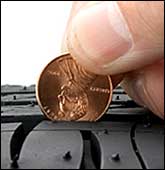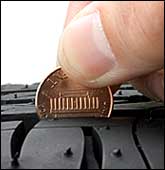Portland Automobile Tire Services
When Should I Replace My Tires?
U.S. coins can be substituted for a tire tread depth gauge as tires wear to the critical final few 32nds of an inch of their remaining tread depth.
Place a penny into several tread grooves across the tire. If part of Lincoln's head is always covered by the tread, you have more than 2/32" of tread depth remaining. |
 2/32" remaining tread depth |
|
Place a quarter into several tread grooves across the tire. If part of Washington's head is always covered by the tread, you have more than 4/32" of tread depth remaining. |
 4/32" remaining tread depth |
|
Place a penny into several tread grooves across the tire. If the top of the Lincoln Memorial is always covered by the tread, you have more than 6/32" of tread depth remaining. |
 6/32" remaining tread depth |
|
The Law
According to most states' laws, tires are legally worn out when they have worn down to 2/32" of remaining tread depth. To help warn drivers that their tires have reached that point, tires sold in North America are required to have indicators molded into their tread design called "wear bars" which run across their tread pattern from their outside shoulder to inside shoulder. Wear bars are designed to visually connect the elements of the tire's tread pattern and warn drivers when their tires no longer meet minimum tread depth requirements.
Common Sense
However, as a tire wears it's important to realize that the tire's ability to perform in rain and snow will be reduced. With 2/32" of remaining tread depth, resistance to hydroplaning in the rain at highway speeds has been significantly reduced, and traction in snow has been virtually eliminated.
If rain and wet roads are a concern, you should consider replacing your tires when they reach approximately 4/32" of remaining tread depth. Since water can't be compressed, you need enough tread depth to allow rain to escape through the tire's grooves. If the water can't escape fast enough, your vehicle's tires will be forced to hydroplane (float) on top of the water, losing traction.
If snow covered roads are a concern, you should consider replacing your tires when they reach approximately 6/32" of remaining tread depth to maintain good mobility. You need more tread depth in snow because your tires need to compress the snow in their grooves and release it as the they roll. If there isn't sufficient tread depth, the "bites" of snow your tires can take on each revolution will be reduced to "nibbles," and your vehicle's traction and mobility will be sacrificed. Because tread depth is such an important element for snow traction, winter tires usually start with noticeably deeper tread depths than typical All-Season or summer tires. Some winter tires even have a second series of "wear bars" molded in their tread pattern indicating approximately 6/32" remaining tread depth to warn you when your tires no longer meet the desired tread depth.
As a Portland Automotive Center dedicated to comprehensive services, Steve's offers Portland Tire Services, including Portland High Performance Tires.
Visit the rest of our website to find out more about how Steve's Automotive of Portland Oregon can make your auto repair experience the best it can be.
Call Us: 503-227-4112 | Get A Quote | Make An Appointment
Photos by Photo Art Portraits, Eben Waggoner Photography and Olive Photography


